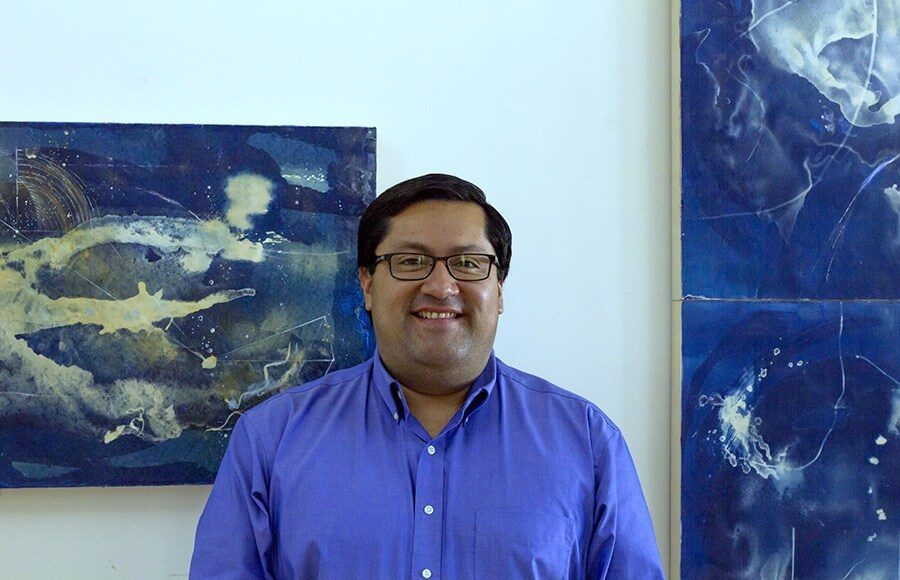JANUARY 16, 2018

VISUAL ART
Civic Center Art Exhibition reappropriates office space into museum for Berkeley’s artistic community

Foreground paintings by Ann Holsberry
BY LLOYD LEE | STAFF
Boxes of miscellaneous documents line the left-hand side of the wall of the mayor and councilmembers’ offices like a silent but conspicuous demand for the staff’s attention. But opposite the towers of cardboard boxes, Civic Arts Coordinator Mary Ann Merker can see contemplative framed artworks elegantly subverting the familiar tropes of a desolate office environment.
“It’s just joyful,” Merker said in an interview with The Daily Californian, speaking of the artworks.
For the past 20 years, the city of Berkeley’s Civic Arts Program, in collaboration with Kala Art Institute, has invited artists — specifically those whose lives have been impacted in some way by the city — to submit artwork for a chance to be showcased in the Civic Center Art Exhibition.
Through a professionally juried selection process, artists, both nascent and seasoned, are chosen based on their ability to reflect the spirit of Berkeley through media ranging from painting and photography to ceramics and textiles.
This year, the exhibition will feature works from 30 Berkeley-based artists — all of whom convey their own unique subjects, such as Susan Ashley’s soft pastel Bay Area landscapes and Ceci Bowman’s digital collages celebrating diversity.
“(The Civic Center Art Exhibition) gives local artists an ability to showcase their work. And the city, through its Civic Arts Program, is committed to provide support for new and local artists,” said Mayor Jesse Arreguín.
But the setting of the exhibition itself is just as unique as the artworks it presents — the walls aren’t stark white partitions that can be retrofitted to accommodate the artwork and guide the direction of viewers, as in conventional museums.
Instead, the gallery begins the moment you sign in and pass Walter, the inviting security guard at the front desk, and it continues throughout the six floors of the late art deco-styled Martin Luther King Jr. Civic Center Building — a workspace where the city of Berkeley’s programs and services are determined, where municipal codes and ordinances are enforced and where Arreguín can oversee budget plans for the city’s future.
Archana Horsting, director of Kala Art Institute and a member of this year’s selection panel, testified to the obstacle proffered by the office environment: “We have a lot of handicap(s) because the walls are not clear, freshly painted. The lighting is not gallery lighting and so on. We have to work around people’s posters and piles of information that they put out.”

Joshua Jordan/Senior Staff
Paintings by Ann Holsberry
The challenge to integrate the artwork seamlessly into the practically outfitted office space is evident as you walk along the lightly scuffed walls interrupted by the monotony of doorways, fire extinguishers, electrical outlets and wide file cabinets — things one would usually expect in a working environment.
However, despite these limitations, the nearly 20-year lifespan of the Civic Center Exhibition should be a testimony to the significance it has held for the employees of the Civic Center since the development of the public arts program.
During a period when the building was barren and virtually without art, Merker and Horsting conceived the idea to fill the empty halls of the Civic Center with artwork lent from the Kala Institute. And when the time came to uninstall certain works and return them to their home at Kala, it became clear that the Civic Center Art Exhibition was an office necessity, as evidenced by the disgruntled employees who had grown to appreciate the art’s presence.
Ever since then, Merker has collaborated with Kala to coordinate an invitation for artists’ submissions, gather a selection panelist and hire professional curators and installers such as Alice Wu and Gary Nakamoto in order to ensure a careful treatment and presentation of the artists’ works inside the building.
“It’s a lot of work to put one of these shows together,” Merker emphasized. But it’s also her personal refuge from the usual milieu of paperwork that often surrounds her desk. “The joy for me is to be able to actually meet and talk to the artists who make the work and see the work up.”
Considering that staff members and city officials such as Merker and Arreguín will be exposed to the artwork more than the general public — although the gallery is open to anyone who wants to visit — it would seem then that the critical function of the exhibit extends beyond the celebration of the arts in Berkeley.
Truly, the Civic Center Art Exhibition doubles as a reminder to the officials of the city of the community of artists that still exists within Berkeley, despite the challenges it faces today with rising housing costs and the displacement of artists as a direct consequence.
And in return, with dedicated workers such as Merker, the artists of Berkeley can be reminded that the city has not forgotten about them.
Herein lies the true spirit of Berkeley.
Contact Lloyd Lee at lloydlee@dailycal.org.